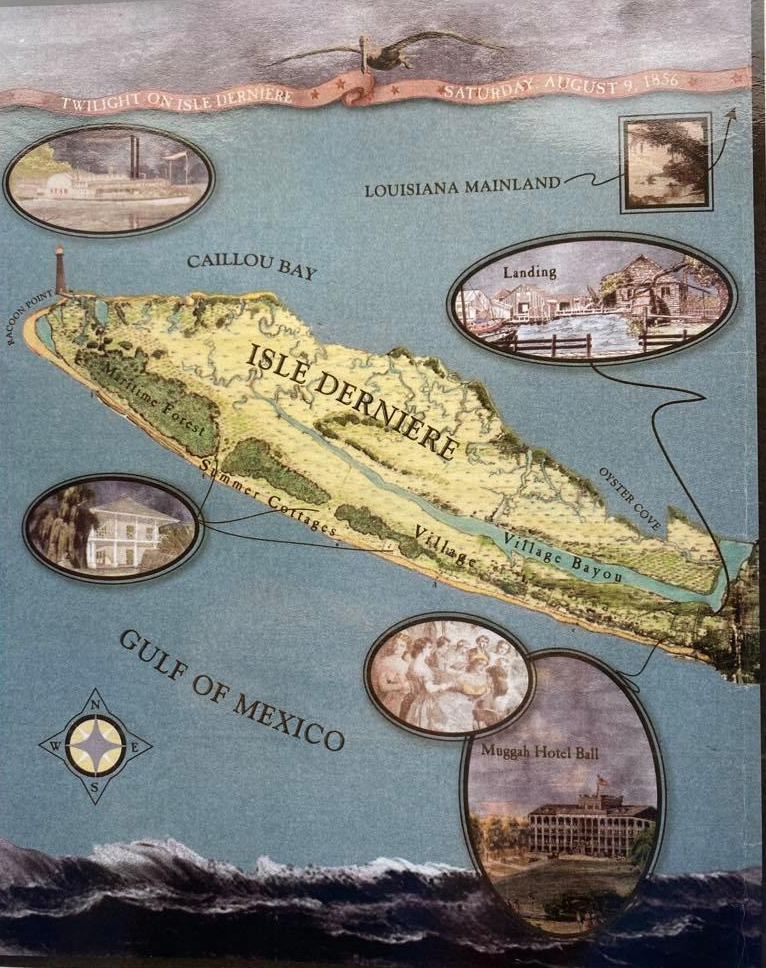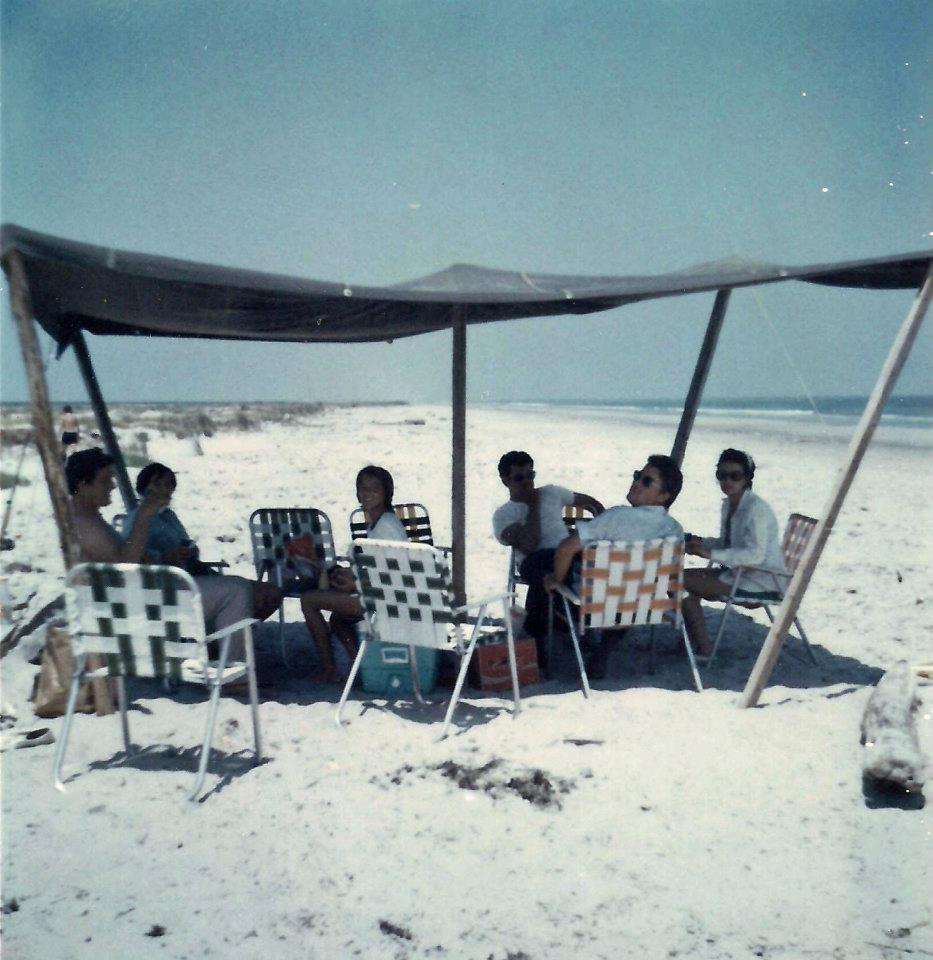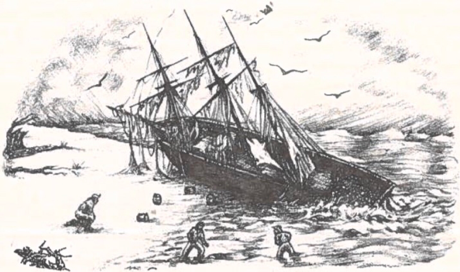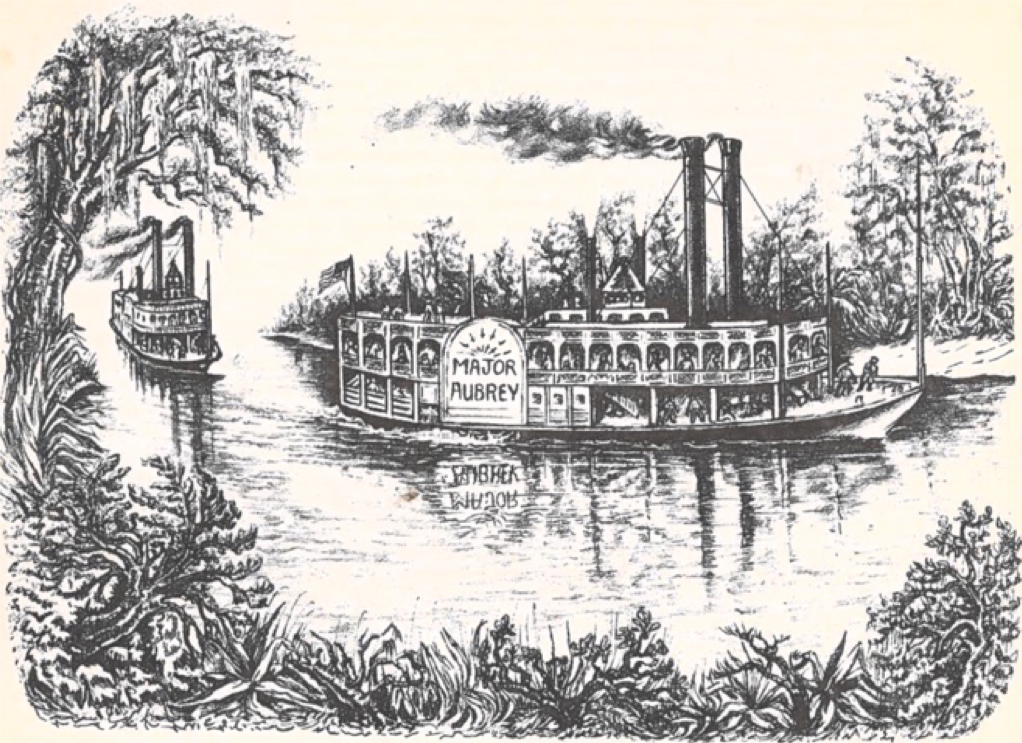LIBRARY BLOG
Remembering Last Island
An island resort. A cataclysmic epidemic. An underestimating crowd. A raging storm.

The fashionable resort was complete with its own harbor, areas for vacationers to fish, boats ready for pleasure rides, and more. This map shows scenes of what the island was like before it was razed, including the well-reported cotillion. Louisiana Endowment for the Humanities\Winter 2002-03
Before the Storm
In 1850s Louisiana, there was a 25-mile-long, approximately half-mile-wide island less than 50 miles off the coast. Isle Derniere, or the Last Island, was once a fashionable vacation spot for the Southern high class. During their extended visits, guests would fish, swim, attend balls, and enjoy the sea air (though women took great care to avoid a tan as pale, blemish-free skin was in vogue). When families were done with their day’s plans, they would retire to the Muggahs’ Hotel, the boarding house, or one of the several private homes they reserved for themselves in the Last Island Village.
The island’s popularity grew around 1853. Yellow fever swept through in one of history’s worse epidemics. For perspective, yellow fever killed 11,000 New Orleans residents in the first year of its course when the city’s population was fewer than 150,000. With a valid reason for fear, several wealthy families flocked to the island to escape sickness. It proved to be an effective strategy. Of all the knowledge we have of yellow fever today, very little was known during the time. Victorian Louisianians picked out the pattern that the disease was less likely to be contracted around salt water. It was a common belief that the salty sea air was something of a cure–all, so the illness not taking hold there seemed reasonable to them. Today, however, we know that yellow fever is carried by mosquitos, which, in turn, cannot thrive in salt-water environments. Nevertheless, their strategic vacations kept them healthy.
As the epidemic continued, a railroad connecting the island to the mainland was completed. A new way of reaching the resort meant another boost in popularity. Thus, the island was teeming with men, women, and children in August of 1856. [1] Riding carriages along the beach, socializing over drinks and billiards, and enjoying “the choicest delicacies,” tourists believed they had escaped disaster, but they had only locked themselves into a different travesty.
A Prelude to Disaster
On Thursday, August 7th, a storm brewed in the Gulf. Without technology like aircrafts or satellites, there was no way for Louisiana residents to know the weather farther out than New Orleans. Only unfortunate ship crews could see what was stirring, unable to get quick word back to land. The revelers on the island were unaware of eminent danger. Even as they awoke the next morning, August 8th, to winds rattling the buildings and waves as high as houses forming on the horizon, they thought themselves to be perfectly fine. One tourist writing about the waves spoke of how they stood in walls of solid water before crashing back down. Michael Schlatre, a ship captain well verse in deciding what is dangerous behavior for water, saw these waves as “peculiar but nonthreatening.”

The completion of a railroad spanning from the Louisiana mainland to Isle Derniere made more opportunities to travel to the island for wealthy Southerners trying to escape yellow fever.
Credit: The Last Storm, James M. Sothern, 1980

130 years later, a family escapes to Last Island for a vacation in the early 80s
Credit: David Duplantis
A group of ship crewmen thought it best to take their load of passengers home that day instead of waiting for their previously scheduled departure times. Captain Thomas H. Ellis respected the judgment of his fellow mariners, but he decided not to take their advice. He reasoned that the women would be anticipating the cotillion being held that night and wouldn’t want to leave before attending. He did manage to have the passengers agree to a morning departure the next day, though. [2]
Only a few hours later, the Muggahs’ Hotel* filled with scores of finely dressed guests laughing and conversing as they feasted and drank, more carefree than they ever were before. As the ladies Captain Ellis was so worried to disappoint danced with their husbands and suitors to a live band playing over the swirling winds, the ship Nautilus—a steamship that shuttled passengers to and from the island—was caught by gales that threatened to capsize the vessel only a few miles away from the island. Despite the warnings, vacationers remained oblivious to the developing hurricane barreling towards them. They were soon to realize the weight of the situation. [3]
The Star and Last Island
Another steamship, the Star, had the misfortune of sailing right into the windstorm as well, blowing the ship off course to the westernmost side of the island (now Raccoon Island). The morning after the ball, Captain Ellis made his morning departure from Isle Derniere to bring his passengers to Brashear City, but when the ship reached Caillou Bay, the wind and the waves grew hazardous. The Star wasn’t made to cut through such unsteady conditions, and soon, the deck filled with water. [2]
The steamer had been due back to the resort’s port that evening; only a few vacationers noticed its absence. [3] By Saturday, August 9th, the winds got to be a Force 12, or 80 miles an hour—the strength of a Category 1 hurricane in today’s measurements—and the Star was still missing. The storm’s intensity grew quickly. By the time it made landfall on August 10th, it had reached Category 4 classification. The highest point on the island rose to a mere five feet above sea level, and the rising Gulf easily overtook the land. Terror seized vacationers and resort employees as it dawned on them they were trapped on the island in the middle of a hurricane. They migrated to higher structures to escape the flooding as they waited for the Star to arrive. Soon after, they saw their salvation. Plumes of black smoke were visible on the horizon—the steamboat had arrived to take them home! Just as their hope was restored, it was crushed as they watched the gales propel the steamer towards the island and into the reeds and tangled grasses near the port. There would be no sailing into safety. [1] The wrecked ship offered some protection at the very least. As the island was submerged underwater and buildings were destroyed, the people sought refuge in the Star as it was the only enclosed and protected space left; this was the only reason why there were as many survivors as there was.

As conditions on the island worsened, vacationers watched in horror as the ship due to bring them home was rendered useless as it was ground ashore by the gales.
Credit: The Last Storm, James M. Sothern, 1980
One by one, houses toppled on the island. Some families sought refuge in Muggahs’ Hotel—boasted to be the sturdiest building on the island. Others, like Thomas Mille and Michael Schlatre’s families, stayed in their private homes and felt as the force of the gales literally pushed the buildings down the beach before they broke apart around the tenants. In Mille’s residence, flying debris from the house’s tumble struck Mille’s eighteen-year-old daughter, Emma, and severely injured her head. It wasn’t long before Mille’s and several other vacationers’ homes were completely decimated. Even the hotel faced a losing battle to the hurricane. The waves roaring across the submerged island swept displaced people away, often times depositing victims directly into the Gulf or into wreckage.
Emma Mille was the only surviving member of her family. She hadn’t lost consciousness when struck by the debris of her house crumbling. She was fully cognizant when she saw one of the torrents on the island drag her sister-in-law—Althee—and Althee’s infant, leading the two forcefully into a large piece of timber from a fallen structure before being swept into the Gulf. Another torrent pulled her under just after she managed to grasp hold of a log to keep herself afloat. Bleeding profusely and most likely in shock, Emma somehow had the strength to keep hold of the wood as was tumbled around the Gulf until a whirlwind drove her back to the island. Richard—Thomas Mille’s body servant whose last name is, unfortunately, unknown—found her sitting dazedly and bloodied on Isle Derniere’s bank, surrounded by corpses as he looked for the living on one of the calmer days following the storm. Without Thomas Mille (at this point, missing and presumed dead) there to approve his actions or give an order, Richard made the choice as a free man to carry Emma back to the safety of the Star. There she was treated by Dr. Alfred Duperier for her extensive injuries. She was in critical condition, requiring much more attention than most of the other injured. She would pull through in a full recovery. However, back in the Gulf, there were more lives at stake. [2]
The Nautilus
As the hurricane rampaged, the Nautilus capsized despite all the crew’s attempts to keep the ship and passengers afloat. James Frisbee, a steward, clutched at wreckage from the ship, unable to do more to save the others. He drifted with another crewman, hoping they would soon wash up on shore or encounter a rescue vessel, but two days passed. Delirious from dehydration, the crewman dove into the heaving waves; Frisbee never saw the man again. Three days after the ship capsized, his makeshift raft was broken up by the waves, and Frisbee struggled to swim over to another castaway floating on a log nearby. As soon as he reached it however, the other man was taken by the waves and dragged under, already dead. Approaching shock from dehydration and almost dead himself, Frisbee eventually used the last of his strength to tug a panel door from the Nautilus over to wedge between the tree roots of his log, climb onto it, and succumb to sleep. As he drifted in the Gulf, Frisbee reached a full week without water—long enough to kill most people. Miraculously, a heavy rain came August 17th, filling the indentations on the panel door and providing nontoxic water for the man to drink. It was enough to keep him alive until the next day when the F.M. Streck sailed in Frisbee’s direction. After over a week lost in the Gulf, Frisbee was saved. He was the only survivor from the Nautilus. [2] The other 81 passengers and crewmen perished.

This statue of Mary used to be on the island, serving as a landmark for passing ships. It has since been moved and now stands in Cocodrie.

The gales from the storm forced the Manilla onto the shore of Timbalier Island before it could complete its voyage.
Credit: The Last Storm, James M. Sothern, 1980
The Manilla
The rig ship Manilla was transporting wine from France to New Orleans and found itself being followed by the hurricane when the crew stopped to enter the Southwest Pass. Knowing they wouldn’t be able to enter, the crew backed into deeper water to anchor for the night and called the pilot station to request an escort ship as they resigned themselves to trying again in the morning, August 10th. The next day only brought winds and waves destructive to the vessel, however, and the Manilla’s wheelhouse, lee bulwarks, and sails were torn away and the cargo was knocked disorganized as the leaking ship inched closer and closer to being forced onto Timbalier Island’s shore. The ship’s captain, William Rogers, was washed overboard twice while he tried to keep the vessel afloat. He was at the end of his 6,000-mile, two-month long journey; he refused to give up until his second tumble into the waves resulted in a shattered femur, and the Manilla was hauled ashore by the gales. Of everyone aboard the ship, all but twelve were accounted for on Timbalier’s shore. Hundreds of casks of French wine were strewn across the Last, Timbalier, and Caillou islands. John McLaughlin, the Manilla’s branch pilot, stood on the bank to preside over what remained of the cargo and watched as wreckage from the Nautilus was carried over by the waves. Speculation of the ship’s fate was confirmed when one of the Nautilus’s distinctive panel doors washed up. The lugger Lone Star was sent to pick up fifteen Manilla survivors** soon after. Prompted by the discovery of the wreckage, an answer to the mystery of how the Nautilus capsized and the whereabouts of the people aboard was still being constructed in New Orleans, but the story would not be known until Frisbee was safely back on land and recovering.
The Aftermath, Rescue, and Current Day
Very few people who had not gone to the Star for protection survived. [2] Michael Schlatre and Thomas Mille were separated from the others on the Last Island and were able to reach New Orleans after five days on a makeshift raft. Schlatre, riddled with broken bones, managed to paddle them to the shore of Bayou De Large. They were found by Captain Charles W. Brien’s crew, who loaded the men onto Brien’s boat and took them back to his home. Schlatre was the only one of his family to make it. Mille, after how long he held on, passed away four days after he was taken to safety. [3]
The island had been razed; instead of being one continuous landmass, it was now segmented in two. Several people found their own dead friends and family members as they combed the island for those who were missing. Some corpses showed signs of the presence of pirates—money stolen from pockets, jewelry snatched from women, knife wounds found on bodies—who had taken advantage on the disorganized state of a resort for the wealthy in the days following the hurricane. The Major Aubrey collected the first round of one hundred survivors on Wednesday, August 14th and set out for the mainland, where passengers took railroads or another ship to get back home. On the 19th, the Texas journeyed to the Isle Derniere to collect a second round of survivors. Emma Mille, now an orphan, accompanied Dr. Duperier to his mother’s house until she was well enough to return to her own family’s empty home. The two had grown fond of each other in their time hiding out in the Star. She and Dr. Duperier later married. [2]

The Major Aubrey was deployed to rescue the first round of survivors.
Credit: The Last Storm, James M. Sothern, 1980
The island has since been segmented into four landmasses called the Raccoon, Whiskey, Trinity, and East Islands respectively. They are collectively referred to as the Isles Dernieres in modern times. Over the centuries, erosion has caused the islands to shrink even more from the days of the hurricane. Looking at it now, it’s difficult to envision a prosperous resort, but just as it offered some reprieve from an epidemic in the years before the storm, it helps today, as well. The four spans of land are now barrier islands. A hurricane might have killed over 200 people on this island, but Isles Dernieres now protects the population of South Louisiana from the same fate and preserves Terrebonne Parish’s wetlands from waves that could easily destroy the already endangered marshes from extreme weather rolling in from the Gulf. [1]

Isle Derniere is now Isles Dernieres, a chain of four barrier islands fortifying Louisiana’s coast.
Credit: Jerome Trosclair
*In some texts, The Muggahs’ Hotel is referred as The Last Island Hotel.
**There were nineteen total survivors, but some did not want to board another ship after what they experienced. [2]
All resources cited can be found in the main library’s reference department or as an e-source on Libby!
- The Last Storm, James M. Sothern, 1980
- Island in a Storm, Abby Sallenger, 2009
- Last Days of Last Island, Bill Dixon, 2011
-Lillian LeCompte, Reference Department

